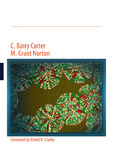Ceramic Materials Science and Engineering
Abstract
In today’s materials science curriculum, there is often only time for one course on
ceramic materials. Students will usually take courses on mechanical properties,
thermodynamics and kinetics, and the structure of materials. Many will also have
taken an introductory overview of materials science. In each of these courses, the
students will have encountered ceramic materials. The present text assumes background
knowledge at this introductory level but still provides a review of such critical
topics as bonding, crystal structures, and lattice defects.
The text has been divided into seven parts and 37 chapters: we will explain the
thinking behind these decisions. Part I examines the history and development of
ceramic materials: how they have literally shaped civilization. We include this
material in our introductory lectures and then make the two chapters assigned reading.
Part II discusses the bonding, structure, and the relationship among phases. Students
often find this part of the course to be the most difficult because structures are
implicitly 3-dimensional. However, so many properties depend on the structure
whether crystalline or amorphous. We have limited the number of structures to what
we think the students can manage in one course, we give references to texts that the
students can spend a lifetime studying and recommend our favorite software package.
Part III consists of two chapters on our tools of the trade. Most ceramics are heated at
some stage during processing. Unfortunately heat treatments are rarely exactly what
we would like them to be; the heating rate is too slow, the furnace contaminates the
sample, the environment is not what we want (or think it is), etc. Techniques for
characterizing materials fill books and the students are familiar with many already
from their studies on metals. So, the purpose of this chapter is, in part, to encourage the
student to find out more about techniques that they might not have heard of or might
not have thought of applying to ceramics; you could certainly skip Part III and make it
assigned reading especially if the students are taking overlapping courses. Part IV
discusses defects in ceramics and aims at providing a comprehensive overview while
again not being a dedicated book on the subject. Part IV leads straight into Part V—a
basic discussion of mechanical properties applied specifically to ceramics. The last
two parts contain just over half the chapters. The two topics are Processing (Part VI)
and Properties (Part VII) and are, of course, the reason we study ceramic materials.
The warning is—these topics form the second half of the book because the student
should understand the materials first, but it then becomes too easy to miss them in a
one-semester course due to lack of time. We know, we have done this and the students
miss the part that they would often appreciate most. Chapter 36 is probably the most
fun for half the students and both the authors; Chapter 37 is the most important for all
of us.

